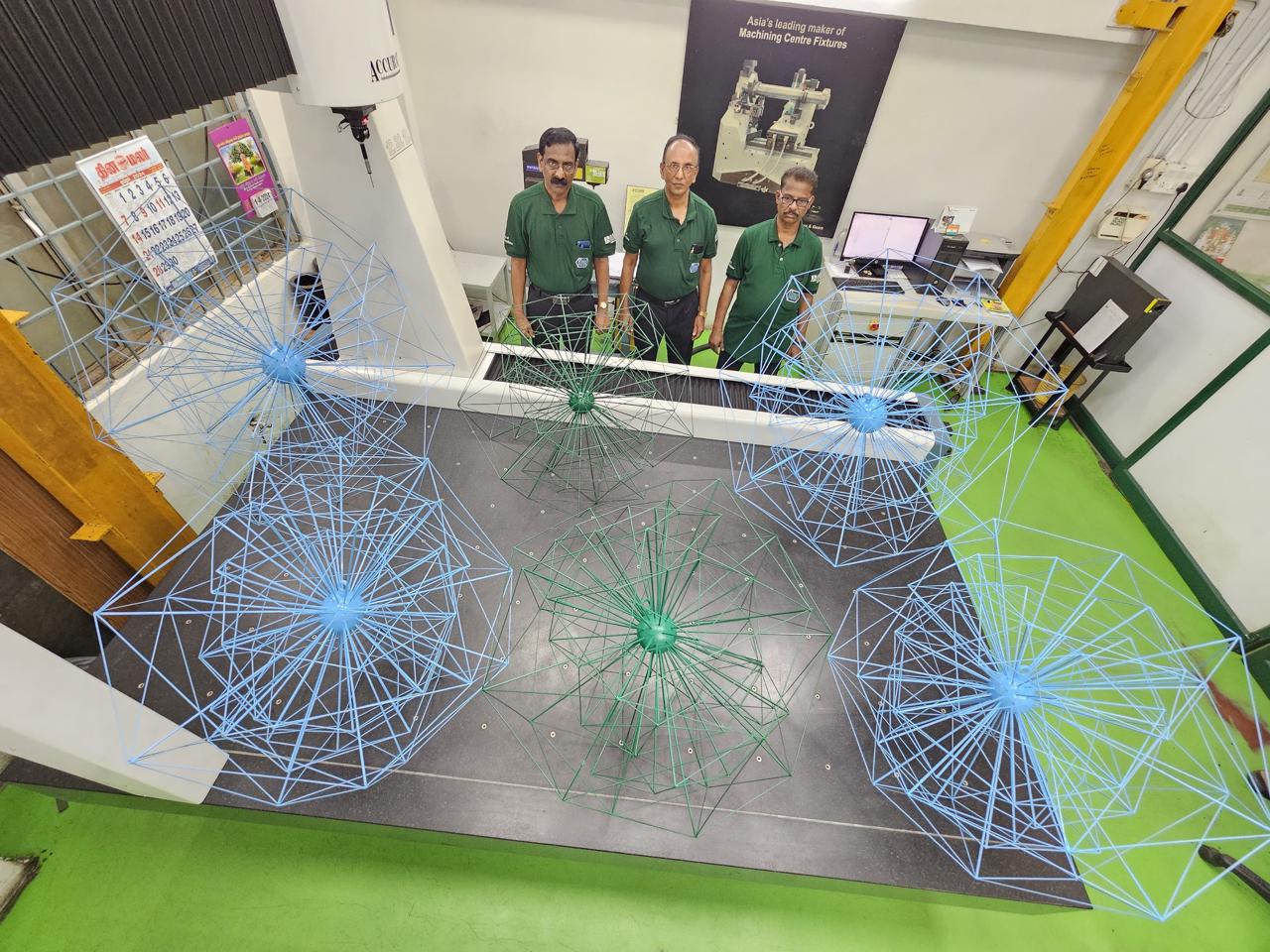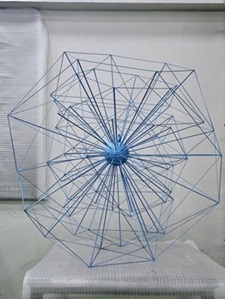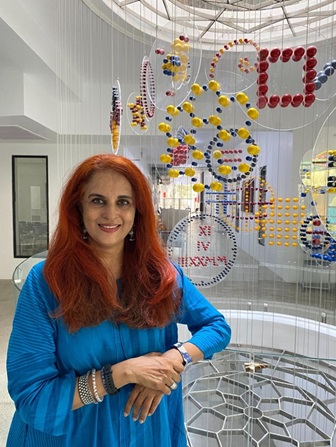Breaking The Barriers Between Art and Engineering

Left vs Right Brain
The German car company BMW ran an ad featuring the Dutch Engineer and Kinetic Artist Theo Janson, a few years back. In the ad Janson says, "The walls between Art and Engineering exist only in our minds. And only a few have the imagination to see beyond them".
The intersections between art and engineering are indeed more profound and intertwined than what meets the eye. By breaking free from the constraints of rigid categorizations - form vs function, left vs right brain, creativity vs logic can enable the individual to tap into a vast pool of potential that lies within us.
|
Recently the eminent, award-winning visual artist Parvathi Nayar collaborated with one of India's oldest and best reputed Fixture building companies, Forms and Gears, on a landmark project, that was a perfect example of this coming together of two varied disciplines. The resulting piece titled “Ocean’s Breath” will be inaugurated as part of the permanent “The Living Ocean” exhibition at Dakshinachitra Museum, Chennai on April 13th at 3pm. The installation captures the spirit of the Ocean and the microscopic diatoms that live in the water. Diatoms give us about 40 per cent of the oxygen we breathe, and in doing so, keep us alive. They possess characteristics of both animals and plants and are encased in elaborate silica shells, which fascinates Parvathi. The Collaboration Parvathi says, "I’m an artist who likes collaboration and the synergies that arise with it. With regards to the creation of “Ocean’s Breath”, I was looking for a way in which the truth of my drawings could be expressed in metal - in a manner that would be honest to the particularities of both media." |
Parvathi Nayar, Visual Artist & Creative Writer |
"The sphere is a form that appeals to me because it is a 3-D rendering of the point or pointillist form that I use in my drawings. I wanted to focus on the spherical-shaped diatoms in this installation – though in my drawings I have worked with diatoms of all shapes," she adds
The collaboration took the form of trying out different metals, tools and various engineering processes to manufacture the art work, while staying true to form, and ensuring the integrity and feel of the original drawings were retained in the 3D metal work. The impetus for this particular collaboration was “The Living Ocean” exhibition curated by Parvathi at Chennai’s prestigious and immensely popluar Dakshinachitra Museum. “The Living Ocean” is a hybrid show that both celebrates the Ocean and examines the deep stresses placed on the Ocean by Climate Change, pollution and other human activities.
It is an exhibition that is immediate and eternal, in how it looks at the Ocean in its immensity, as well as how human action is endangering it.
Reji Varghese, Partner of Forms and Gears says, “Our team studied Parvathi's detailed drawings and other installations she has created such as the iconic Dreamcatcher. A previous installation she had done on diatoms in a different medium caught our eye - in this work she had used transient materials as it was a temporary installation in Singapore. However our team was of the opinion that the forms Parvathi had created would translate well into metal."
True Seeing
There is a difference between observing and merely looking. Varghese says," For engineers its all about dimensions, tolerances, manufacturability and functionality. For us working with Parvathi was like learning to "see again" When the coloured lenses of the engineer came off we began to look at things like how a visual artist would - a skill that comes about through a detailed study of compositional elements such as shape, color, form and style".
" 'True seeing' is when both the left and right brain work together and this requires intuition, focus and training the eye to see differently", he adds.
The Process

Forms and Gears assembled its most experienced team consisting of E. Thayananthan, Design Head with over 50 years of machine design experience, S. Manorajakumar, Manufacturing Head with 42 years of fixture and machine building experience, C. O. Abraham, Head of Applications and Projects who just completed his 50th year of service and A. Vasu, Tool & Die maker who has over 44 years’ experience and who's family has been working for 3 generations with Forms and Gears.
The Forms and Gears team, working closely with Parvathi, tried different maquettes, using wire, solid rods, tubing, hollow forms, sheet metal and experimented with various processes.
Reji says, "There were a lot of challenges in the “manufacturabilty” of the items such as extremely long cantilevered rods, brazed at one end to stay true to the original centre line of the sphere. There were many such rods on one sphere and even a slight deviation from the centre line would distort the symmetricity of the piece".
"As the complete art work was to be suspended from the roof we also had to take into account the weight of the structure and a finite element analysis to predict how the art piece which was a combination of 10 subsystems would react to real-world forces of vibration, heat, air flow, etc. But we overcame those challenges as there was an interesting give and take of ideas and a willingness to experiment, improvise and be flexible", he adds.
What resulted was a series of 10 intricate diatoms of two different sizes, with the whole artwork spanning 3.5 meters x 4 meters, which Californian artist Piyali Banerjee calls, "An art and engineering masterpiece" that will be hung from the ceiling to create an abstract expression of looking up at a vast oceanic space.
Water is a through-thread in Parvathi’s art practice, which examines the narratives of spatial relationships, both internal/intimate spaces, and external/public ones. Water flows in her work, whether as the Ocean, rivers and other waterbodies, or as a threatened resource and essential part of the environment and Nature, or as a meditative substance born in the stars. She often uses science and technology as a medium to explore the world through unusual microscopic and macroscopic perspectives.
The Future
Parvathi and Reji plan to take their collaboration further for corporates and for public spaces like airports, galleries etc. The duo see great synergies in bouncing ideas off each other and creating works that is a coming together of technology and art.
Reji says, " New technology and advanced manufacturing techniques have expanded the artistic toolbox, allowing artists to experiment with new mediums and techniques. 3D printing for example can create elaborate and intricate physical sculptures and structures based on digital designs, merging the virtual and physical realms".
"Virtual Reality and Augmented Reality have also revolutionized the way we experience art. It will be exciting to experiment with various evolving technologies to push the boundaries of what is possible in the art world", says Reji.
Parvathi Nayar is a New Delhi born visual artist and creative writer. She is best known for her art videos, installations, drawings, and photography. She created the artform of “Drawn Sculpture”, as seen in the seminal artwork “A Story of Flight”. This 20-foot-high drawn sculpture artwork is installed at T2, in the new Mumbai airport as part of Jai He, one of the largest public art collections in India.
Parvathi's work has been widely collected by individuals and institutions in India and abroad, including the Singapore Art Museum, Sotheby's Institute of Art, The Australia India Institute, Deutsche Bank, BMW and others.

Reji Varghese, Partner, Forms and Gears
Reji Varghese is a Designated Partner of Forms and Gears, an ASM Group company. He is one of the co-founders of the popular Jazz-Rock band Second Coming and is also a well-known journalist and guest writer for a number of leading national newspapers.
Article Source: Team MMI
Image Source: Forms and Gears




 Facebook
Facebook.png) Twitter
Twitter Linkedin
Linkedin Subscribe
Subscribe